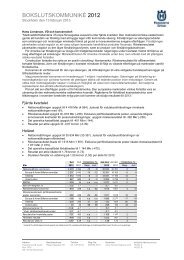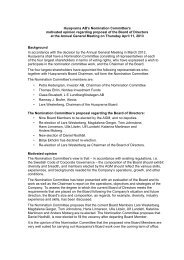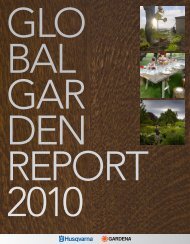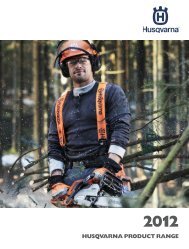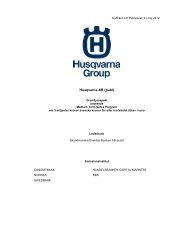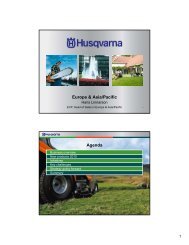Annual Report 2009 - Husqvarna Group
Annual Report 2009 - Husqvarna Group
Annual Report 2009 - Husqvarna Group
Create successful ePaper yourself
Turn your PDF publications into a flip-book with our unique Google optimized e-Paper software.
42 <strong>Husqvarna</strong> <strong>Annual</strong> <strong>Report</strong> <strong>2009</strong> <strong>Report</strong> by the Board of Directors<br />
Risks related to restructuring<br />
The <strong>Group</strong> is currently undertaking a number of structural<br />
changes of the manufacturing footprint and the sales organization,<br />
as well as implementing a new organization. Restructuring<br />
and organizational changes always involve the risk of creating<br />
higher costs than anticipated and losing key personnel, or<br />
that estimated savings deviate, both up and down, from<br />
announced targets.<br />
Financial risks<br />
<strong>Husqvarna</strong>’s financial risks are managed on the basis of the<br />
<strong>Group</strong>’s financial and credit policies, which are annually<br />
updated and authorized by the Board of Directors. Management<br />
of such risks is based largely on the use of financial<br />
instruments and is mainly centralized to <strong>Group</strong> Treasury, which<br />
operates in accordance with specified risk mandates and limits.<br />
For more information on risk management, risk exposure<br />
and accounting principles, see Notes 1 and 2.<br />
Currency exposure<br />
The goal of <strong>Husqvarna</strong>’s currency management is to minimize<br />
the short-term adverse effects of currency exchange-rate fluctuations<br />
on the <strong>Group</strong>’s earnings and financial position. As<br />
<strong>Husqvarna</strong> sells its products in approximately 100 countries,<br />
the <strong>Group</strong> is exposed to such fluctuations. They affect the<br />
<strong>Group</strong>’s earnings in terms of translation of income statements<br />
in foreign subsidiaries, i.e. translation exposure, as well as the<br />
sale of products on the export market and purchases of materials<br />
in foreign currencies, i.e. transaction exposure.<br />
Translation exposure is related primarily to earnings in USD,<br />
EUR, PLN, RUB and GBP. The <strong>Group</strong>’s globally widespread<br />
production and sales enable the various exchange-rate effects<br />
to offset each other to some extent.<br />
Changes in exchange rates also affect <strong>Group</strong> equity. The<br />
difference between the assets and liabilities of foreign subsidiaries<br />
in foreign currencies is affected by such changes, which<br />
generate translation differences that impact equity. At yearend<br />
<strong>2009</strong>, most foreign net assets were in USD and EUR. For<br />
more information on risks related to currency exposure, see<br />
Note 2.<br />
Hedging of currency exposure<br />
<strong>Husqvarna</strong> uses currency derivatives to hedge estimated<br />
transaction exposure on a horizon of 0–12 months. Normally,<br />
75–100% of the invoiced and estimated currency flow for the<br />
next 6 months is hedged, and 50–75% for the next 6–12<br />
months. At year-end <strong>2009</strong> the market value of the <strong>Group</strong>’s<br />
hedges referring to transaction exposure amounted to<br />
SEK –68m (–35).<br />
In accordance with the <strong>Group</strong>’s financial policy, certain foreign<br />
net assets are hedged through loans in the respective<br />
country’s currency, as well as through currency derivatives.<br />
Currency gains and losses on net assets and hedges are<br />
booked directly to other comprehensive income. Interest<br />
income and expense related to hedging are reported under<br />
net financial items.<br />
Costs for hedging of foreign net assets in <strong>2009</strong> amounted<br />
to SEK –18m (21).<br />
Interest-rate risk<br />
At year-end <strong>2009</strong>, the average interest rate on external borrowings<br />
was 3.2% (4.3) and the average fixed interest-term was<br />
2.2 years (0.4). On the basis of the volume of borrowings and<br />
the fixed interest-term at year-end, a one percentage point<br />
shift of the interest rates would impact group income in the<br />
amount of –/+ 38m (80). For more information on interest rate<br />
risk, see Note 2.<br />
Financing risks<br />
Financing risks refer to possible delays, increased costs or<br />
cancellations related to financing of <strong>Husqvarna</strong>’s capital<br />
requirements and refinancing of outstanding loans.<br />
Financing risks can be reduced by maintaining an evenly distributed<br />
maturity profile for loans, and by ensuring that shortterm<br />
borrowings do not exceed current liquidity. The <strong>Group</strong>’s<br />
financial policy stipulates that net debt should be long-term,<br />
without reference to seasonal variations. The <strong>Group</strong>’s goal is<br />
for the average maturity period of long-term loans to be not<br />
less than two years and to show an evenly distributed maturity<br />
profile. Loans with maturity periods of less than 12 months are<br />
normally maximized to SEK 3,000m.<br />
Net sales and exchange rates<br />
Net sales, SEKm <strong>2009</strong><br />
Average exchange rate, SEK<br />
Year-end exchange rate, SEK<br />
<strong>2009</strong> 2008 <strong>2009</strong> 2008<br />
USD 13,689 7.63 6.59 7.18 7.70<br />
EUR 7,938 10.63 9.67 10.30 10.94<br />
CAD 1,619 6.67 6.21 6.85 6.25<br />
GBP 1,138 11.84 12.11 11.39 11.20<br />
JPY 1,063 0.08 0.06 0.08 0.09



